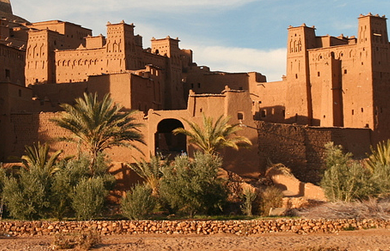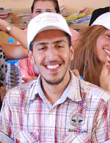A Semester Abroad in a Forgotten Capital
Souhaib Ben Kchouh 12 February 2016 A Semester Abroad in a Forgotten Capital The aim of this exchange report is to familiarise future exchange students with my exchange destination and to prepare them for their upcoming discretionary semester. First of all, I will introduce the minor. Then, I will speak about housing, finances and insurance. Finally, some cultural differences will be highlighted.
Study Programme Abroad
The Minor that I followed in Morocco, precisely in Rabat, is called: Social Studies of Morocco. It started on August 31st 2014 and ended on January 27th 2015. The institution that is offering this minor is called NIMAR (Nederlands Instituut Marokko). This minor program offers an exclusive package of courses and activities that focuses entirely on the social scientific study of Morocco. Besides a lecture series, the program includes intensive language instruction, as well as a field excursion and a field research project. A variety of excursions are organized in order to provide additional opportunities for students to enrich their experience and understanding of Moroccan society. The language of instruction is English. This minor program is uniquely designed for students in social science degree programs in the Netherlands, and offers them an opportunity to gain in-depth understanding of all aspects of Moroccan society. However, it is also available for BA International Studies students. Furthermore, the minor is taught from a predominantly anthropological perspective, and focuses primarily on qualitative research methods. Another interesting aspect of this minor is that several components of the program will be taught by Moroccan instructors.
Three phases
The minor consists of three main phases; 1) Instruction, 2) Fieldwork and 3) Paper. The first phase of the minor program, the instruction period, is considerably intensive and will demand of participating students a significant dedication of time and effort. Students will take five courses; besides time spent in class (19 hours per week), students will be expected to spend additional time on literature assignments, homework, and practicum projects (20 hours per week).
The five courses offered during this instructional period are:
- Social Scientific Enrichment (2x2 hrs/week, 32 hours total)
- Language Instruction Moroccan Arabic (3x2 hrs/week, 48 hours total) hours total)
- Weekly excursions (1x3 hrs/week, 24 hours total) and one five-day excursion
- Methods and techniques of qualitative research (M&T) (1x2 hrs/week, 16 hours total)
- Workshop on research design (1x2 hrs/week, 16 hours total, 2 hours group work excluded)
The second phase is the research period. During this phase, students will carry out an independent field research project in Rabat or surroundings. The research will be carried out in small groups. Students will be advised by the instructor for the SSRM and research design workshops. Research topics will be related to the current theme of the minor. Students are required to do a research with an organization or institution in Rabat and/or surroundings. Some of these have been visited earlier in the program. Besides, students are expected to be highly independent and self-sufficient in carrying out their projects, from searching for literature to conducting interviews in a foreign language.
The last phase of the minor program is devoted to the composition of a research paper. This paper should be a concise report of research findings, written in English, and should be between 15 and 20 pages long. Empirical research findings should be discussed within a relevant theoretical framework. This phase of the minor program is 4 weeks long. Because this phase is dedicated to the writing of the final paper, students are not required to stay in Morocco. It is important, however, that students remain in regular contact with their advisor.
Housing
The costs of housing in Rabat are relatively high, between 4,000 MAD (approx. 370 EUR) and 8,000 MAD (approx. 740 EUR). Bigger apartments cost 1000 MAD (approx. 925 EUR). Students may hire this apartment together with other students and share the costs. However, NIMAR offers housing as well. Students may stay with a Moroccan family for 400 EUR or hire a NIMAR apartment for around 550 EUR. In my case, I have contacted one of my acquaintances who arranged a small apartment for me in Tamara (a city near Rabat).
Finances and insurance
The costs for living in Morocco are not so high. For example, a litre of milk costs only 50 cents and bread costs 10 cents. Students can buy their daily needs from the grocery or the supermarket. In regards to the costs of study materials, you are asked to buy just two books. All other required readings are uploaded on Blackboard. Before I travelled to Morocco, I called my insurance to tell them that I am going for a semester abroad. They told me that I am internationally insured. So I did not change anything. However, I think that it is better to contact your insurance for more information.
Social Life and Cultural Differences
It is very hard to find a specific definition of a regular day in Morocco because each day seems to have an adventure of its own. Of course, I had classes every day, but you will have time to discover new things and enjoy your stay in Morocco. Sometimes it seems that simply stepping out the door is a new adventure, no matter how small. Although Rabat seems ‘westernised’, it is still not hard to find a new experience, even if it is only talking to someone on the street. People in Morocco are open and welcoming. You can easily start a conversation with a complete stranger (literally everywhere). Aside from the conversations, there are endless amount of cafes in Rabat to explore, and the whole maze-like medina (old city). Cafes are useful both for socialising with people and for getting the large amounts of homework done. Besides cafes, you may pay a visit to the various museums of Rabat or simply go to the beach to surf! Do you want to visit another city? Take the tram and go to Salé. Salé and Rabat are divided by the Bouragreg River. Salé, like most Moroccan big cities, has two ‘sub-cities’, the old medina and the ville nouvelle (the new city). This division traces its history to the French Protectorate in Morocco in 1912, as the old medina was reserved for the Moroccans and the ‘ville nouvelle’ was the place where Europeans settled. However, wealthy Moroccans have taken over the houses in the ville nouvelle after the independence as they fled the hustle of the crowded old medina. Today Salé is considered as a 'dormitory town' because people sleep in Salé, but work in Rabat. This is because the costs of life and rent are much cheaper in Salé than in Rabat. Yet, there are some ‘modern’ houses and villas that are being built in the expensive segments of the city, especially along the river Bouragreg. Salé is divided into two centres: the economic centre and the religious centre. These two centres are separated from each other. Despite the fact that the streets in the economic centre are narrow and confusing, they are structured. Every street has a name and its own speciality. There is a street for the gold traders, one for clothing, and another for wood carvers and a fourth for carpet merchants. Besides these shopping streets, there is also a suq (market). The products offered in the suq are seasonal as most of the merchants sell, for example, at the beginning of the school year pens and notebooks, and during Ramadan (The islamic fasting month) they sell bowls and wooden spoons, which are used to drink herira (Moroccan traditional soup). The religious centre of Salé is located in a different place from the economic centre of the city. This is done in order to not bother people in this part by traders and commerce. With the exception of the Grand Mosque Hassan II in Casablanca, Non-Muslims are not allowed to enter the mosques, because Morocco is following the Maliki school of thought. The religious centre has also a medrasa (school). The medrasa is a beautiful decorated building where young pupils obtain religious knowledge. Morocco is a very diverse country. I might speak the whole day about the economic and cultural differences in Morocco and still not cover everything. Therefore, it is fascinating to discover this amazing country by yourself!



